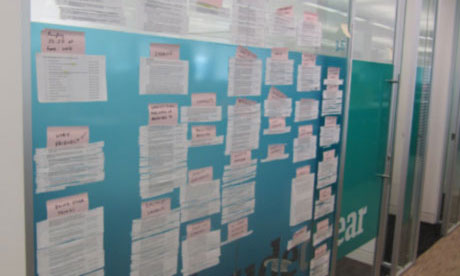I have recently completed a research project into live blogging at Guardian.co.uk as the dissertation element of an MSc in Electronic Publishing at City University. The project was suggested by my supervisor after a presentation by Martin Belam and Karen Loasby, the UX team at the Guardian.
Guardian readers will be familiar with the concept of live blogging, as the site has been using the format to report sport since the late 90s and deliver breaking news and follow major cultural events since 2007.
The first news live blog was “Shamblog: Shambo to the Slaughter” on 26 July 2007, and since then has increasingly used the format to report on rapidly developing breaking news stories, such as natural disasters and public protests, as well for long running live blog series such as Politics Live and Middle East Live.
Live blogs are significantly different from other ways of reporting news, not least because they are entirely web native, as Matt Wells, Blogs and Networks Editor, told me:
Live blogs are not like anything else. You can’t print them out, you can’t broadcast them, you can’t put them on television, they only work in the digital format in which they have developed so that’s what makes them work so well online and on mobile.
While there is already a body of academic research available on the subjects of social media and blogging in general, there hasn’t been much work done to date on the phenomenon of live blogging, and as an Electronic Publishing student, being one of the people to try to get this conversation started was an exciting prospect.
The project was designed to explore both the production and consumption of live blogs focusing on personal experiences, and produce a snapshot of any major usability issues. Guardian journalists and other staff were very helpful in giving up their time to be interviewed about their own experiences and opinions of the live blog format. This phase of the project was originally to be followed by interviews with users about their experiences reading live blogs, what they liked and disliked about them, and how easy they were to navigate.
Initially I thought it would be difficult to recruit participants, and that maybe, I’d get 10-20 responses, but I received 400 responses to my initial call out for interview participants and as a result decided to carry out a longer survey, along with some short follow-up interviews.
Part of the reason the response was so overwhelming was that the survey took place during the first two weeks in August when the News of the World phone hacking scandal was at its height, and many people were attracted to the way a live blog allows them to stay up-to-date with a rapidly developing story. Many respondents told me they had only started reading live blogs because of this particular story, and were now addicted.
The follow-up survey generated 189 responses and gave me some valuable insights into how readers feel about different aspects of the live blog format and reading experience, and offered some avenues for further research which I hope will be useful for the Guardian UX team.
They’ve cut out lots of quotes from the interviews and surveys, and have them pasted up on the walls of the Guardian office to keep a focus on the users as they design improvements to the system.
